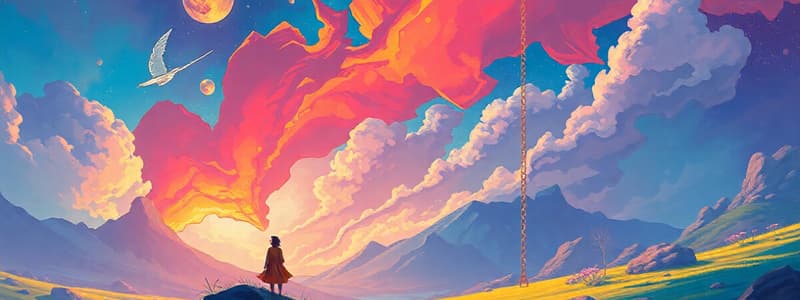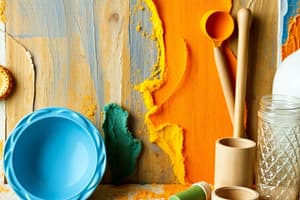Podcast
Questions and Answers
Match the following elements of design with their definitions:
Match the following elements of design with their definitions:
Space = The area within, around, above or below an object Line = A mark made by a tool or instrument Shape = A two-dimensional area defined by contrast Texture = The surface quality of an object
Match the types of lines with their descriptions:
Match the types of lines with their descriptions:
Vertical lines = Lines that move up and down without any slant Horizontal lines = Lines that are parallel to the horizon Diagonal lines = Lines that slant Curved lines = Lines that change direction gradually
Match the terms related to pressure with their meanings:
Match the terms related to pressure with their meanings:
Pressure = A force used by the hand of an artist Stroke = A line that refers to a continuous thread Short strokes = Individual strokes that change direction occasionally Continuous strokes = Strokes that maintain a consistent direction
Match the art principles with their roles in composition:
Match the art principles with their roles in composition:
Match the stroke types with their characteristics:
Match the stroke types with their characteristics:
Match the types of shapes with their characteristics:
Match the types of shapes with their characteristics:
Match the following elements of art with examples:
Match the following elements of art with examples:
Match the types of pressure on strokes with their descriptions:
Match the types of pressure on strokes with their descriptions:
Match the following geometric shapes with their descriptions:
Match the following geometric shapes with their descriptions:
Match the following terms with their definitions regarding texture:
Match the following terms with their definitions regarding texture:
Match the properties of color with their explanations:
Match the properties of color with their explanations:
Match the primary colors with their names:
Match the primary colors with their names:
Match the types of colors with their categories:
Match the types of colors with their categories:
Match the definitions of warm and cool colors:
Match the definitions of warm and cool colors:
Match the following characteristics with their respective elements:
Match the following characteristics with their respective elements:
Match the following components of a color wheel with their types:
Match the following components of a color wheel with their types:
Study Notes
Elements of Art
- Space: The area within, around, above, or below an object. Crucial for both 2D and 3D art. 3D space is literal; 2D space is an illusion. Artists use techniques to create depth illusions in 2D work.
- Point: Has no dimension. A dot represents a position in space.
- Line: A path of a moving point. Considered the most basic element of art. Types include:
- Vertical: Up and down.
- Horizontal: Parallel to the horizon.
- Diagonal: Slanting.
- Curved: Gradually changing direction.
- Pressure & Stroke: Artists use pressure to create varying line values or strokes. Strokes can be long and continuous, or short, broken, and cross-hatched.
Shape
- A shape is created when a line is enclosed. Two main types:
- Geometric: Regular shapes (square, circle, triangle, rectangle, oval) that appear as if made with tools.
- Organic/Free-Form: Irregular shapes, often curved or angular, found in nature (e.g., clouds, pebbles). Shapes contribute to composition and balance in artwork.
Form
- Form is a three-dimensional object.
Texture
- Refers to the surface quality (rough, smooth, soft, hard, glossy).
- Can be actual (physical) or visual (apparent).
- Types: actual, simulated, invented.
Value
- Refers to the lightness or darkness of a color, also called tone.
- A gradual change from light to dark creates shading, and can be applied using various techniques. Light to dark ranges from white to black.
Color
- A basic element of art, produced by light waves.
- Objects reflect specific wavelengths, determining their perceived color.
- Properties of color:
- Hue: The name of a color (red, blue, green).
- Intensity/Saturation: The purity or dullness of a color.
- Value: The lightness or darkness of a color.
- Color Wheel: A visual aid depicting color relationships. Developed by Sir Isaac Newton.
- Primary Colors: Red, yellow, blue. Equally spaced.
- Secondary Colors: Orange, green, purple (violet). Created by mixing primary colors.
- Tertiary Colors: Red-purple, red-orange, blue-green, blue-purple, yellow-green, yellow-orange. Created by mixing primary and secondary colors.
- Color Temperature: Warm colors (red to yellow) vs. cool colors (blue to green/violet).
- Neutral Colors: Black, white, gray. Not categorized as warm or cool.
Studying That Suits You
Use AI to generate personalized quizzes and flashcards to suit your learning preferences.




